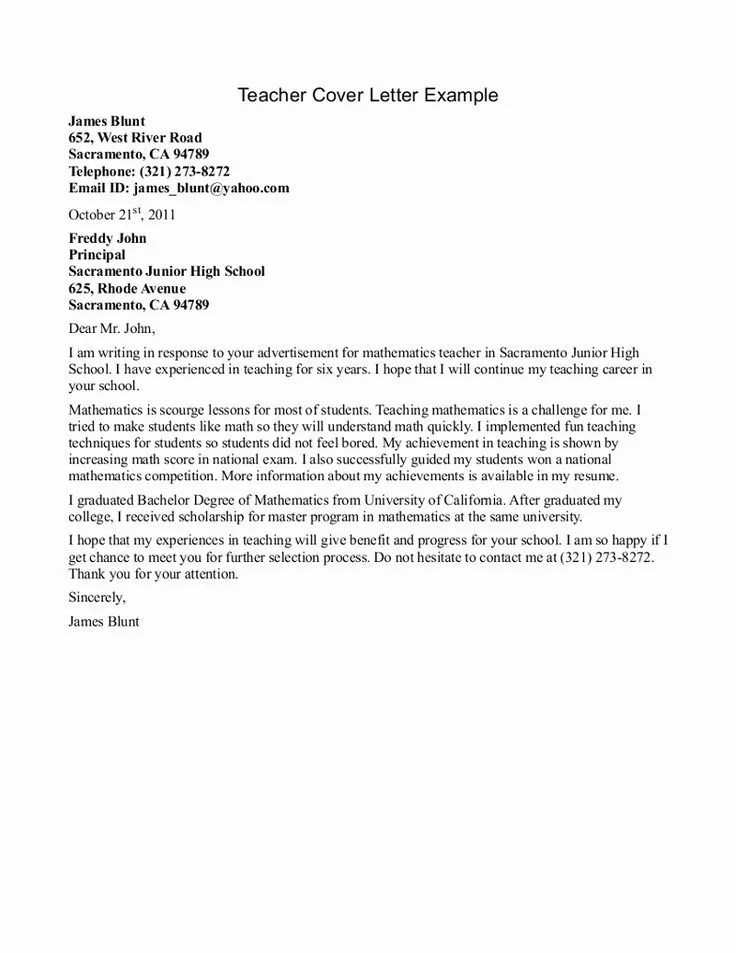Cover Letter for Teacher Assistant Job Overview
Securing a Teacher Assistant position often hinges on a well-crafted cover letter. It serves as your introduction, showcasing your skills, experience, and passion for supporting students and educators. This guide provides a comprehensive roadmap to writing a compelling cover letter, increasing your chances of landing an interview. A strong cover letter is not just a formality; it’s a crucial opportunity to differentiate yourself from other applicants and demonstrate your suitability for the role. By following the steps outlined in this guide, you can create a cover letter that effectively highlights your qualifications and resonates with potential employers.
Understanding the Role of a Teacher Assistant
Before you start writing, understanding the role of a Teacher Assistant is essential. This helps you tailor your cover letter to the specific requirements of the job. Teacher Assistants play a vital role in the classroom, supporting both teachers and students. They contribute to creating a positive and effective learning environment. Their responsibilities vary depending on the school and grade level, but generally involve assisting with lesson preparation, supervising students, and providing individual or small-group support. A clear understanding of these duties is crucial for writing a relevant and impactful cover letter.
Key Responsibilities of a Teacher Assistant
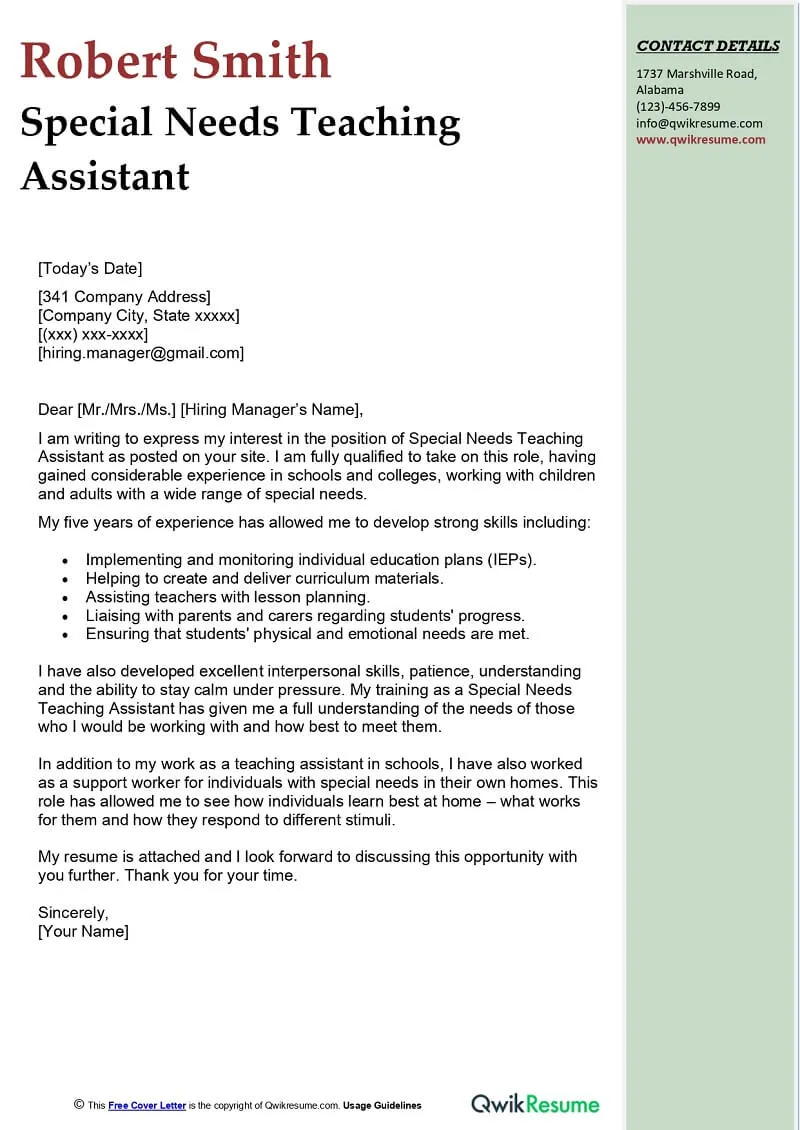
Teacher Assistant responsibilities encompass a wide array of tasks. These include preparing classroom materials, grading assignments, and providing one-on-one or small-group assistance to students who need extra help. Additionally, they often supervise students during activities, such as recess or lunch. Teacher Assistants also help maintain classroom organization and create a conducive learning environment. Furthermore, they may communicate with parents, attend staff meetings, and assist with administrative tasks. Highlighting your ability to handle these responsibilities showcases your versatility and commitment to supporting student success.
Essential Skills for a Teacher Assistant
A successful Teacher Assistant possesses a diverse set of skills. These include strong communication and interpersonal skills, patience, and the ability to adapt to different learning styles. Organization, time management, and the ability to multitask are also crucial. Moreover, a good Teacher Assistant is empathetic, supportive, and able to create a positive rapport with students. Other important skills include basic computer proficiency, knowledge of classroom management techniques, and a willingness to learn and grow. Highlighting these skills in your cover letter will demonstrate your competence and suitability for the role.
Crafting a Strong Cover Letter
Writing a strong cover letter involves several key steps, from formatting to content. A well-structured cover letter not only showcases your qualifications but also demonstrates your professionalism and attention to detail. The following sections will guide you through each element of crafting a cover letter that captures the reader’s attention and makes a lasting impression. By carefully following these steps, you will be able to create a cover letter that sets you apart from the competition.
Header and Contact Information
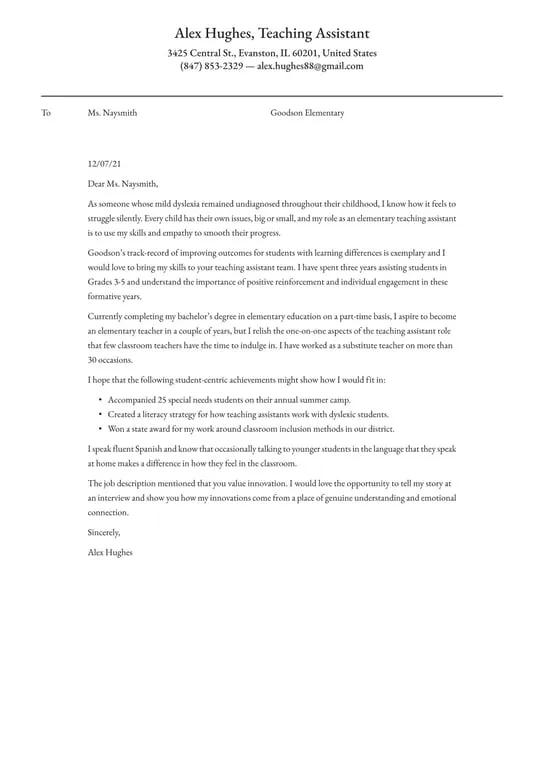
Begin your cover letter with a professional header. This should include your full name, address, phone number, and email address. Include the date and the recipient’s name, title, and the school’s address. Accuracy is paramount here. It is important to ensure that all details are correct, as this is a reflection of your attention to detail. Use a clear and easy-to-read font. Ensure your contact information is up-to-date, so the school can reach you easily.
Formatting Your Cover Letter
The formatting of your cover letter is as important as its content. Use a standard font, such as Times New Roman or Arial, in a readable size (11 or 12 points). Maintain consistent spacing throughout, typically single-spaced with a space between paragraphs. Use left alignment and avoid justification. Keep the letter concise, ideally no more than one page. Proofread carefully for any spelling, grammatical, or punctuation errors before submitting. Proper formatting enhances readability and demonstrates professionalism.
Writing an Engaging Opening
The opening paragraph is your first opportunity to grab the reader’s attention. Start by clearly stating the position you are applying for and how you learned about the opening. Then, write a brief, compelling statement about why you are interested in the role and what you can bring to it. Consider mentioning a specific achievement or skill that directly aligns with the job requirements. Avoid generic phrases. Make sure your introduction reflects your enthusiasm and sets a positive tone for the rest of the letter.
Highlighting Your Relevant Experience
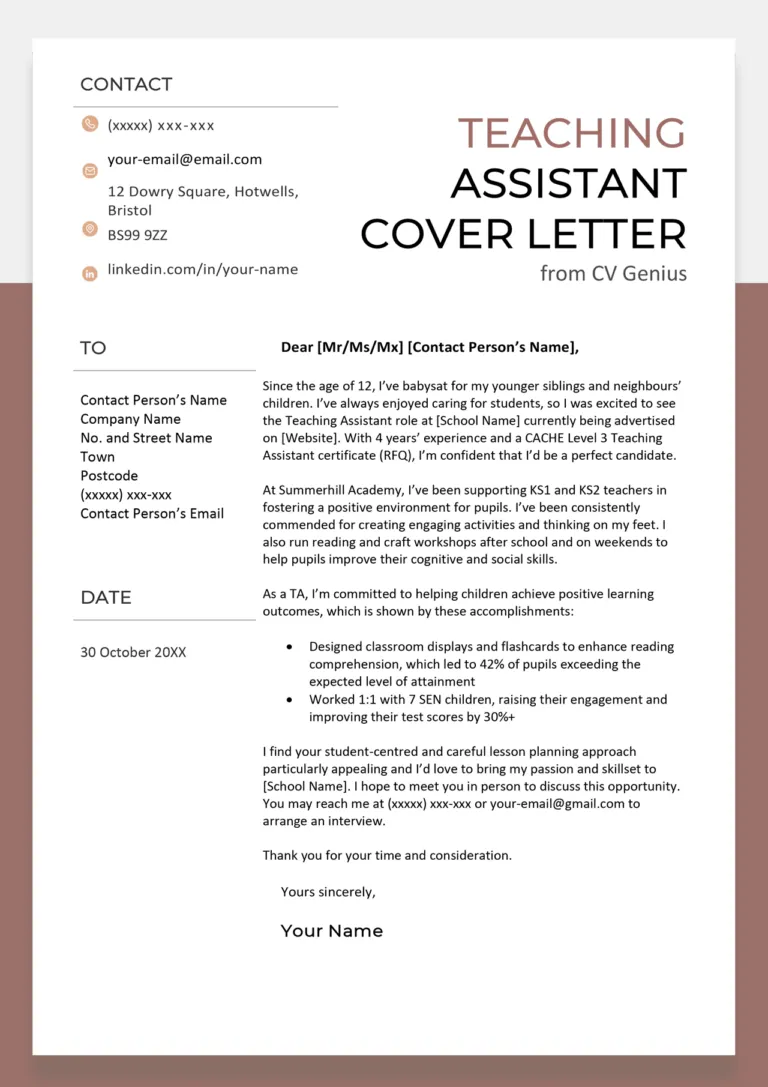
The body of your cover letter should showcase your relevant experience. Provide details about your previous roles, emphasizing the responsibilities and accomplishments that align with the Teacher Assistant position. Use specific examples to demonstrate how you have supported teachers, assisted students, or contributed to a positive learning environment. Use action verbs to describe your experiences and quantify your achievements whenever possible. This section should provide a clear picture of your abilities and how you can contribute to the school.
Emphasizing Your Skills and Qualifications
In addition to experience, highlight your skills and qualifications. Review the job description and identify the key skills the employer is seeking. Then, provide concrete examples of how you have demonstrated these skills in the past. These skills could include communication, organization, classroom management, or any other relevant expertise. Use the STAR method (Situation, Task, Action, Result) to provide context and showcase your ability to address challenges and achieve positive outcomes. This section is critical for demonstrating your fit for the position.
Quantifying Your Achievements
Quantifying your achievements makes your cover letter more impactful. Instead of simply stating that you “assisted students,” provide measurable results, such as “Increased student participation in class discussions by 20%”. Quantifiable data strengthens your claims and gives the reader a clear understanding of your impact. This can include numbers, percentages, or any other metrics that showcase your successes in previous roles. Highlighting achievements with numbers is a strong way to prove your abilities.
Showcasing Your Passion for Education
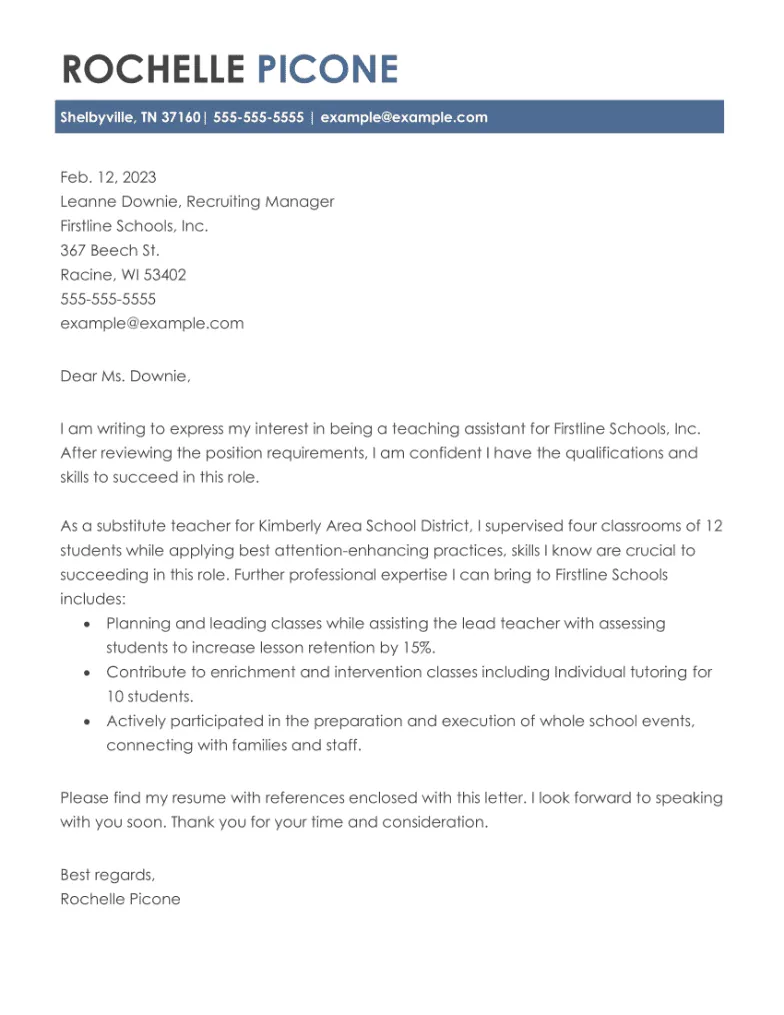
Demonstrate your passion for education throughout your cover letter. Share why you are drawn to the role and what motivates you to work with students and educators. Talk about your commitment to fostering a positive learning environment, supporting student success, and contributing to the school’s mission. This is an opportunity to connect with the reader on an emotional level and demonstrate your genuine enthusiasm for the position and the field of education. Be authentic and let your passion shine through.
Closing Your Cover Letter Effectively
End your cover letter with a strong closing paragraph. Express your interest in an interview and reiterate your enthusiasm for the position. Thank the reader for their time and consideration. Provide your contact information again, making it easy for them to reach you. A polite and professional closing statement leaves a positive impression. Make sure you mention that you’re available for an interview and look forward to discussing the opportunity further.
Proofreading and Editing Your Cover Letter
Before submitting your cover letter, proofread it carefully. Check for any spelling, grammar, or punctuation errors. Make sure the tone is professional and that your message is clear and concise. Read the letter aloud to catch any awkward phrasing. Consider having a friend, family member, or career counselor review your letter as well. A well-proofread cover letter demonstrates your attention to detail and professionalism, leaving a lasting impression on the hiring manager.
Tailoring Your Cover Letter
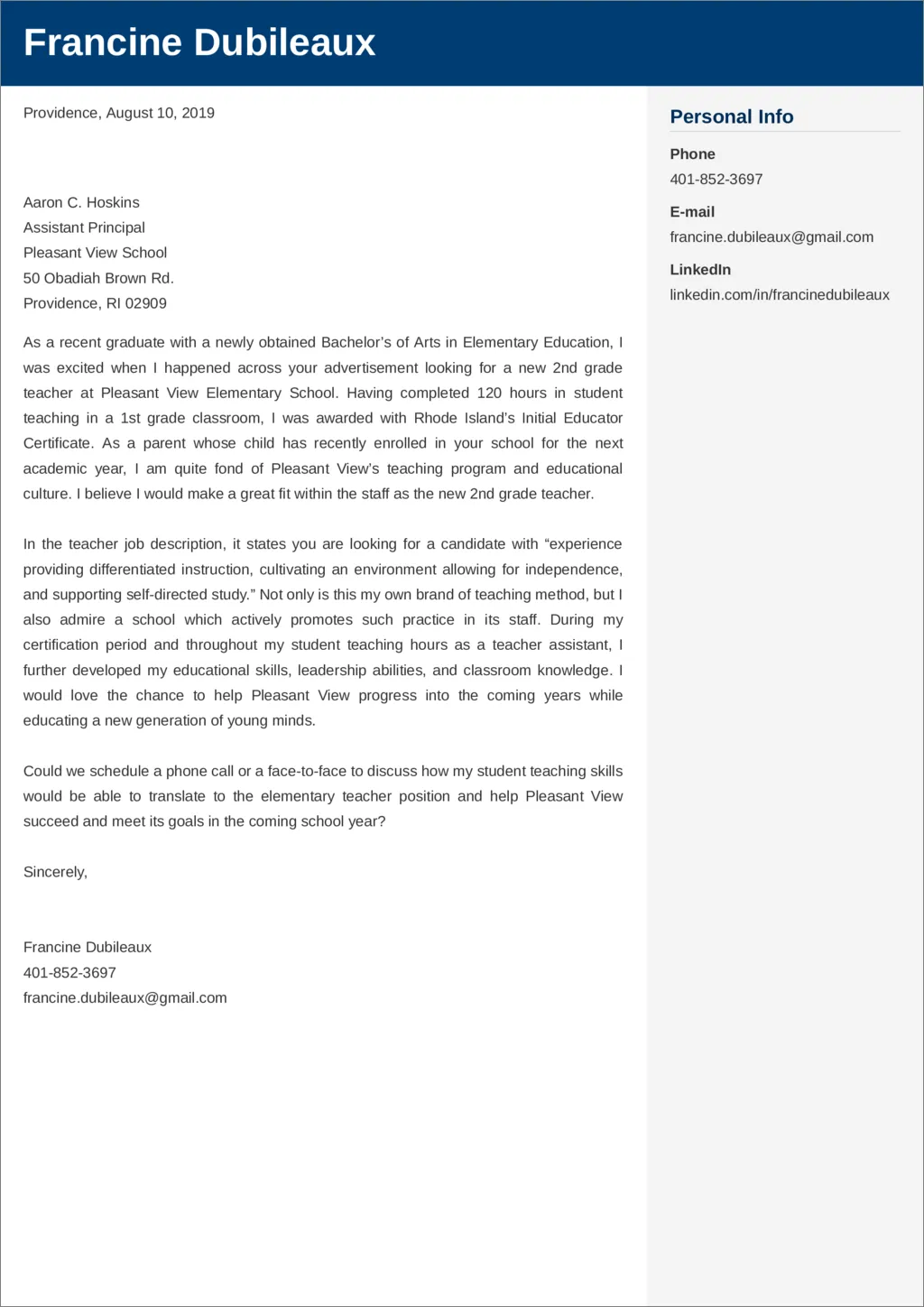
Tailoring your cover letter to each job application is crucial. Avoid using a generic cover letter. Customize it to reflect the specific requirements and preferences of the school or district. Research the school’s mission, values, and any specific initiatives. This shows your interest and that you understand the school’s needs. By tailoring the cover letter, you show the employer that you are genuinely interested in the specific opportunity.
Researching the School or District
Researching the school or district is a vital step in customizing your cover letter. Visit the school’s website to learn about its mission, values, and programs. Read about their recent achievements and any initiatives. This shows your interest and that you are interested in the school’s needs and values. This will help you tailor your letter to address their specific needs and demonstrate your suitability for their culture. Mentioning specific programs or values shows that you are a good fit.
Matching Skills to Job Requirements
Carefully review the job description and identify the key skills and qualifications the employer is seeking. Then, make sure to highlight these skills in your cover letter. Provide specific examples of how you have demonstrated these skills in your previous roles. When possible, use the same keywords and phrases from the job description. This demonstrates to the hiring manager that you have the skills and experience they need.
Using Keywords from the Job Description

Incorporate keywords from the job description throughout your cover letter. This is an important step in getting your application noticed. Keywords help the hiring manager see how your skills align with their requirements and can also help your application pass through applicant tracking systems. Be sure to use these keywords naturally and avoid keyword stuffing. This ensures that the letter is readable and that your skills match the job requirements.
Cover Letter Examples
Reviewing cover letter examples can provide valuable insights into writing your own. Examples offer templates and structure and can give you ideas for phrasing and content. Adapt the examples to your situation. Remember to tailor them to your specific experience and the requirements of the job description. Varying the format may help you get the results you want. Here are a few common examples.
Example 1 Focus on Experience
In this type of example, the focus is on prior experience and the skills gained from those experiences. The candidate should be able to elaborate on previous Teacher Assistant positions held, detailing responsibilities and accomplishments. It is important to quantify achievements, such as the number of students assisted, any classroom management improvements, or any special projects managed. This example is a great template if you have a lot of experience, providing solid examples of your past success.
Example 2 Focus on Skills
This kind of cover letter focuses on your skills. If you’re new to the role or shifting careers, this template is a good fit. Here, the emphasis is on demonstrating the skills you have acquired through various experiences, even if those experiences weren’t in a formal teaching setting. It’s crucial to align your skills with the requirements in the job description, such as communication, patience, organization, and teamwork. This type of cover letter needs to convince the reader of the skills you’ll bring, even without direct experience.
Example 3 Focus on Education
This example is suitable for candidates with a strong educational background, such as those with degrees in education or related fields. It should highlight your academic achievements, including any relevant coursework, certifications, or specializations. Explain how your education has prepared you for the role and how you can apply your knowledge to support student learning. Include any volunteer work, practicums, or research related to education. This type of cover letter is useful if you have a good educational background.
Common Mistakes to Avoid
Avoiding common mistakes can significantly increase your chances of getting an interview. These errors can instantly make you seem unprofessional or disinterested. By being aware of these pitfalls, you can ensure your cover letter makes a positive impression and strengthens your application.
Grammar and Spelling Errors
Errors in grammar and spelling can undermine your credibility. Always proofread your cover letter multiple times and use a grammar checker. Incorrect grammar and spelling suggest a lack of attention to detail. Ensure that the writing is free of any typos or grammatical errors. Reading your letter aloud can help you identify any awkward phrasing or mistakes. Attention to detail is important in education, so making sure your cover letter is perfect is a must.
Generic Cover Letters
Sending a generic cover letter is a common mistake. This makes it seem like you’re not genuinely interested in the specific position or school. Tailor your letter to each job application, highlighting your understanding of the school’s mission, values, and the specific requirements of the role. Personalize your letter and mention specific reasons why you want to work at that particular school. This will make the employer more interested in you. Customization proves your interest and effort.
Lack of Enthusiasm
Failing to convey enthusiasm can make your cover letter seem bland and uninspired. Your passion for supporting students and educators should shine through. Express your excitement about the position, and clearly state your reasons for wanting the job. Demonstrating this genuine interest through a well-written and engaging cover letter. Your enthusiasm is essential, showing a sincere interest in the position.
Submitting Your Cover Letter
The final step is submitting your cover letter. The way you submit your cover letter reflects your attention to detail. Follow the instructions provided by the school or district and ensure that your letter is formatted correctly. These steps increase your chances of a positive response.
Choosing the Right Format
Choose the correct format for submitting your cover letter. If you’re submitting it online, make sure it is in an acceptable file format, such as PDF. Ensure the formatting remains consistent when you save and upload the file. For physical mail, use high-quality paper and a professional envelope. Choose the right format to show respect for the application process.
Following Submission Instructions
Always carefully follow the submission instructions provided by the school or district. Pay attention to deadlines, the required file format, and any specific requirements. Failing to follow these instructions can result in your application being rejected. Adhere to all instructions to ensure that the employer receives and considers your application. Following instructions demonstrates attention to detail, which is essential for the job.
